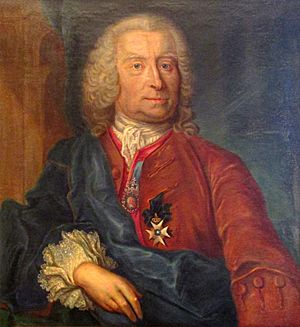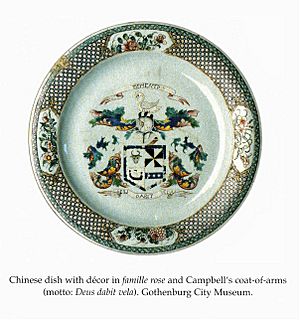Colin Campbell (Swedish East India Company) facts for kids
Colin Campbell (born November 1, 1686 – died May 9, 1757) was a Scottish businessman. He helped start the Swedish East India Company. He was also the first special representative, or envoy, sent by Swedish King Fredrik I to the Emperor of China.
Contents
Who Was Colin Campbell?
Colin Campbell was born in November 1686 in Edinburgh, Scotland. His father, John Campbell, was a lawyer and an important person in the city. Colin was the youngest of three brothers. Like their father, all the brothers became lawyers and merchants. A merchant is someone who buys and sells goods. In 1720, Colin became a "Burgess" of Edinburgh. This was a special title given to important citizens.
A Fresh Start in Ostend
In 1723, Colin lost a lot of money. This happened because of a huge financial crash called the "South Sea Bubble." He had invested a lot and ended up deeply in debt. Colin promised to pay back all his debts, which he did before he died. But to escape his debtors, he had to leave Scotland.
He went to Ostend in Belgium. At that time, Ostend was part of the Austrian Netherlands. There, Campbell helped the Austrians try to create their own trading company. This company would compete with the British East India Company. He worked there until 1730, mostly as a supercargo. A supercargo is a person on a merchant ship who manages the cargo and sales. The Austrian company didn't do well, mainly because Britain opposed it. So, Colin moved to Stockholm, Sweden, and then to Gothenburg in 1731. Gothenburg was Sweden's main port.
Building a Company in Gothenburg
In Gothenburg, Colin Campbell joined forces with rich and powerful Swedes. One of them was Henric König, a broker from Stockholm. Henric had connections to King Fredrik I. Another partner was Niclas Sahlgren, a merchant who had worked with the Dutch East India Company. Sahlgren invited Campbell to Sweden to work on a new trading idea.
Starting the Swedish East India Company
In April 1731, the Riksdag (Sweden's Parliament) approved a special document from the King. This document, called a Charter, gave the new Swedish East India Company a complete monopoly. This meant they were the only Swedish company allowed to trade with the "East Indies." The "East Indies" meant any port east of the Cape of Good Hope in Africa.
The Company promised to pay the King about 25,000 silver dollars for each voyage. The Company became very successful, making its Directors, including Campbell, very rich. Since only Swedes could be Directors, Colin Campbell became a Swedish citizen on June 14, 1731. He was also given a noble title and a special coat of arms. His motto was "Memento Deus dabit vela" which means "Remember that it is God who fills the sails."
First Trip to China
The Ship and Crew
The Swedish East India Company's first ship was named the Fredericus Rex Sueciae. It sailed from Gothenburg on February 9, 1732. Colin Campbell was the main supercargo on this trip. This meant he had all the Company's authority. Even the First Captain, Georg Herman Trolle, had to follow Campbell's orders. Many foreigners were on board, including the Second Captain, George Kitchin, and several assistants to Campbell.
Special Messenger to China
Colin Campbell also carried special travel papers and a passport. These papers said he was a minister plenipotentiary to the Emperor of China and other Asian rulers. A minister plenipotentiary is a diplomat with full power to represent their country. These papers were written in Dutch, just in case the Dutch navy stopped them. They were indeed stopped by the Dutch.
Campbell never actually met the Chinese Emperor. However, he did create a lasting and profitable trading connection between Sweden and the city of Canton in China.
The Long Journey
The trip lasted 550 days, which is about a year and a half. They stayed in Canton for 120 days. Most of the Company's later trips also went to Canton. The ship sailed past Norway, Cádiz in Spain, and around the Cape of Good Hope. Then it went to St Paul Island, through the Sunda Strait, and finally to Canton. They arrived on September 19, 1732.
Stopped by the Dutch
On the way home, on February 3, 1732, seven Dutch ships stopped them in the Sunda Strait. The Dutch officers did not accept Campbell's travel papers. They took most of the crew off the ship and put Dutch soldiers on board. They ordered the ship to sail to Batavia, which was the main Dutch base. Only Colin Campbell was left on the ship.
In Batavia, the Dutch Governor General, Dirck van Cloon, looked at Campbell's papers. He apologized and let Campbell continue his journey on February 9. Campbell had been keeping a diary of the voyage. But when the Dutch approached, he destroyed it. He didn't want them to think he was spying or find out any secret business information. Years later, Campbell was able to remember and rewrite his diary.
Back Home
The ship then sailed back to Europe. They stopped at Fernando de Noronha, an island off the coast of Brazil. Here, they got more supplies and recovered from scurvy, a sickness caused by lack of Vitamin C. On September 7, 1733, the Fredericus Rex Sueciae was back in Gothenburg. The trip had taken eighteen months.
Campbell immediately complained about how the Dutch had treated them. Despite the delay, the voyage was very successful. Shareholders received a first payment of 25% of their investment back, and then a second payment of 50%.
A Rich and Successful Life
Over the next 15 years, the Swedish East India Company made more than 20 successful voyages. Colin Campbell became very rich. He paid off all his old debts and lived a prosperous life until he passed away in 1757.



